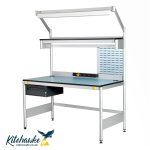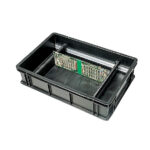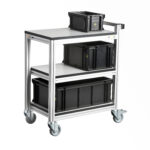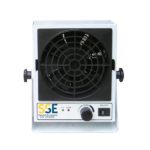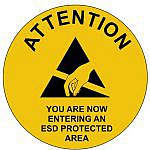What is ESD?
ESD is the abbreviation of electrostatic discharge. ESD is the sudden transfer of electrical charge between two differently charged objects, or between a person and an object. ESD is measured in volts. The higher the voltage generated, the greater the risk of the ESD event.
As ESD damage can occur when there is a difference in charge between objects, protection against ESD damage is achieved by equalising the charge so that the system unit, the component, the work surface and the person handling the component are all at the same charge.
Any system component that contains transistors or integrated circuits should be considered electrostatic discharge sensitive (ESDS).
What types of damage can be caused by ESD?
- Catastrophic Failure is permanent damage to an ESDS component from an ESD event
- Latent Failure is a failure of the component, or malfunction, following normal use caused by an earlier ESD event
- Upset Failure is ESD damage that causes the component to not operate properly when in use
What can cause ESD?
There are 3 potential sources of ESD:
- People: during normal activities, charges will be generated on a person’s body, ranging from a few volts to thousands of volts. Contact with a conductive item (for example, a PCB) will result in a discharge, possibly resulting in ESD damage
- Equipment: all moving equipment can generate static charges and therefore a high risk of ESD
- Charged Insulators: commonly used items, often made from plastics (for example, polyethylene packaging), charge up and retain charge readily. Fields from highly charged items can produce ESD events in devices without physical contact (charge by induction)
How do we reduce the risk of damage from ESD?
To reduce the risk of damage from ESD, an Electrostatic Protected Area (EPA) needs to be established. This is a controlled environment that will comprise equipment and procedures designed to minimise the risk of ESD damage.
How do we setup an EPA?
SSE’s 10 Steps to Create an Effective EPA
- Boundary: define the boundary of the EPA with signage and physical barriers to control access to the EPA
- ESD Floor: install an ESD floor in areas where sensitive components will be handled
- ESD Benches: install ESD benches with static dissipative work surfaces and personnel wrist strap bonding points
- Personnel Grounding: ESD footwear, ESD clothing, ESD wrist straps, and ESD chairs are all examples
- Insulators: exclude all non-essential insulators. Manage the risk of process-essential insulators
- Packaging: provide effective packaging for transit outside the EPA, to shield sensitive electronics from ESD events
- Transport and Storage: ensure all trolleys, shelving and containers used within the EPA are grounded and low charging
- Monitoring: install ESD test equipment for checking personnel grounding items. For example, wrist straps and footwear
- Training: provide training for all staff that handle ESDS items or may be required to operate within the EPA
- Control and Oversight: document the ESD Control Programme and appoint an ESD Coordinator to oversee the programme. Implement testing and auditing procedures
How can SSE help?
One of SSE’s experienced ESD Technical Experts can visit your site, either for a general walk around chat about requirements and plans, or to conduct a detailed independent ESD Survey. They will help you design and build your EPA, whilst guiding you on implementing an ESD Control Plan and testing procedures. Our technical experts can provide informal guidance and support, and for formal training, SSE provide high quality ESD training either offsite for small numbers or onsite ESD training for larger numbers.
Additional to the support and guidance SSE can offer, SSE offers a full range of high quality, competitively priced products to help build and maintain your EPA and supporting functions. From the ESD flooring (including installation) and ESD benches that are the cornerstone of the EPA, through to all of the equipment required to achieve the 10 steps of an effective EPA above.

